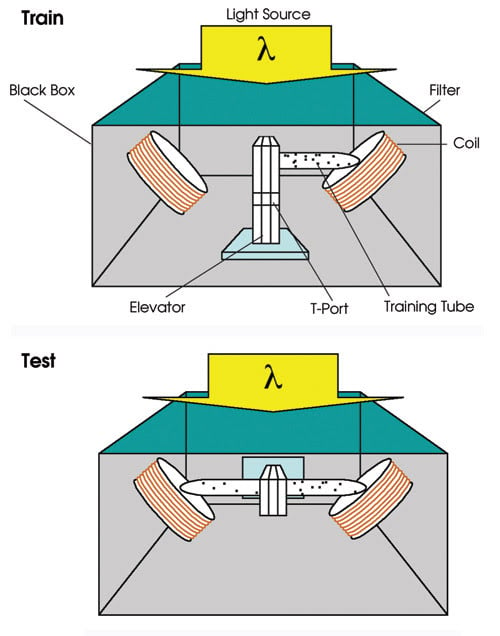
Inside a fly’s built-in compass
Ultraviolet photoreceptor may help flies find their way
Hank Hogan
Flies don’t carry a compass and, in fact, they may not need one because they’re sensitive to magnetic fields. Thus, they can navigate in response to an internal geomagnetic sensor, even when other clues are lacking. The mechanism behind this magnetosensitivity appears to be related to an ultraviolet photoreceptor, according to researchers from the University of Massachusetts Medical School in Worcester.
Flies aren’t the only animals that can sense magnetic fields. This ability plays a role in the migration and movement of many species.
However, just how an internal compass works is a mystery, noted research team leader and neurobiologist Steven M. Reppert. “The ability to sense geomagnetism is the least understood sensory system in all of biology in animals.”
One explanation is that this detection is done via magnetically sensitive radical-pair reactions in specialized photoreceptors. These reactions lead to a response detected by the nervous system that lets the animal know which direction the magnetic field runs.
One candidate photoreceptor for this process is cryptochrome, a flavoprotein found in various versions in nearly all animals. The vertebrate variety of cryptochrome regulates the 24-hour circadian clock and does not appear to be photosensitive. In the fruit fly Drosophila melanogaster, on the other hand, the protein does respond to light.

To test magnetosensitivity in flies, researchers used an illuminated box with coils that can be magnetized and a dual-choice T-port through which flies can move (front views shown). The top diagram shows training of the flies, while the lower one shows testing. By varying the light entering the chamber, researchers could prove that a specific photoreceptor, cryptochrome, is essential for magnetosensing. Reprinted from Nature with permission of the researchers.
Thus, fruit flies seemed to be good test subjects for researchers trying to understand magnetosensitivity. There are fruit fly varieties that are deficient in cryptochrome, and the fly protein’s sensitivity lies in the UV-A range from 350 to 400 nm and in the near-blue from 430 to 450 nm. This well-defined action spectrum lends itself to experimental manipulation of light.
Eliminating other influences
However, the researchers needed a simple apparatus for the test — one that eliminated the possibility that the flies were responding to heat or sound instead of to magnetic fields. Postdoctoral researcher Robert J. Gegear, using a binary-choice T-maze and a two-coil system, designed the equipment. When the coil was energized, one side of the maze had a magnetic field while the other side had none. This design eliminated differences in heat or other nonmagnetic cues that might be generated by the electric coils during testing.
In their experiments, the researchers worked with flies in their native state and also after training. In both cases, they allowed the flies to enter a dual-choice port, with a coil facing both ports. They illuminated the box with light and activated the coils. In the training sessions, hungry flies were rewarded with sucrose, reinforcing preference for the magnetized coil.
The researchers then studied the flies when exposed to light under various conditions. Trained flies developed a statistically significant preference for the magnetic field, with the magnitude of response varying by subspecies and with eye color having no effect.
What did have an impact was the nature of the light. Under full-spectrum light, the flies headed for the magnetized coil. When filters blocked light below 420 nm, that preference disappeared. This outcome wasn’t a result of the decrease in illumination intensity brought about by the filters, because flies under dimmer but full-spectrum light could evidently still sense the magnetic field and still head for the appropriate coil. The researchers restored some of the magnetic-sensitive behavior of the flies by allowing light down to 400 nm into the box.
“We looked at the light requirement and the spectrum of light that was needed for the magnetosensitive response of the fly, which was in the UV to blue range, and it matched exactly what the action spectrum is for the cryptochrome protein in the fruit fly,” Reppert summed up.
The group further proved the essential nature of cryptochrome by examining two separate strains of mutant flies deficient in the protein. These flies did not have a native response to the magnetic field and could not be trained to respond.
In flies, light-activated cryptochrome interacts with other proteins to reset the circadian clock. The researchers examined whether or not this internal clock is needed for magnetosensitivity by subjecting the flies to constant light for at least five days. After this complete disruption of the normal 24-hour cycle, the flies still reacted to the magnetic field much as they had before. The work is detailed in a Nature paper published online July 20, 2008.
Reppert noted that this research shows that the protein is essential for sensing magnetic fields but doesn’t prove that cryptochrome is the magnetoreceptor itself. Further work will be needed to establish that, but he said they now have a well-characterized system to study this possibility. Another research avenue will involve inserting the protein in specific cells in the eyes and brains of flies that currently don’t have it to determine which cells mediate the response.
Finally, there’s the fact that there are two different classes of cryptochrome proteins in animals. The first class is light-sensitive, while the second does not appear to be. However, the second group is found in a broad range of animals, including vertebrates. Some of these animals migrate long distances, and some appear to use some geomagnetic sensing as a navigation aide.
With fruit flies, it should be possible to test whether that second group of proteins also functions as magnetoreceptors by creating flies that produce the nonlight-sensitive class of proteins. That could answer some questions about a large group of animals, Reppert said. “We can begin to see whether their cryptochromes can mediate this response.”
Published: September 2008